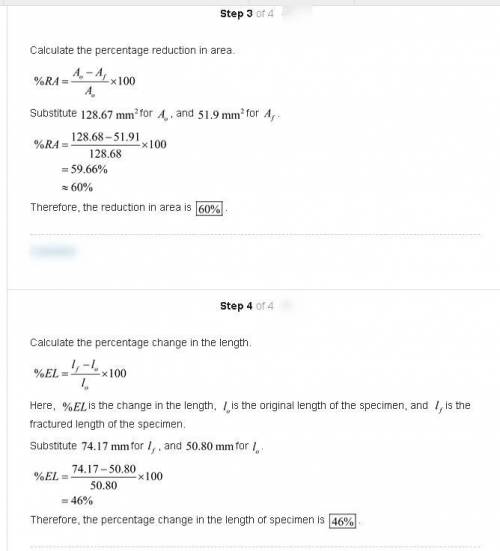
Engineering, 06.05.2020 23:08, coco4937
A cylindrical metal specimen having an original diameter of 12.8 mm (0.505 in.) and gauge length of 50.80 mm (2.000 in.) is pulled in tension until fracture occurs. The diameter at the point of fracture is 8.13 mm (0.320 in.), and the fractured gauge length is 74.17 mm (2.920 in.). Calculate the ductility in terms of percent reduction in area and percent elongation.

Answers: 1
Other questions on the subject: Engineering

Engineering, 03.07.2019 15:10, brooklyn674
Apiston-cylinder with a volume of 0.25 m3 holds 1 kg of air (r 0.287 k/kgk) at a temperature of 100 c. heat transfer to the cylinder causes an isothermal expansion of the piston until the volume triples. how much heat is added to the piston-cylinder?
Answers: 3

Engineering, 04.07.2019 18:10, ashleybaber4966
If a particle moves along a path such that r : (3 sin t) m and ? : 2t rad, where t is in seconds. what is the particle's acceleration in m/s in 4 seconds? a)- 16.43 b)- 16.29 c)- 15.21 d)- 13.79
Answers: 1

Engineering, 04.07.2019 18:10, wirchakethan23
Hydraulic fluid with a sg. of 0.78 is flowing through a 1.5 in. i. d. pipe at 58 gal/min. the fluid has an absolute viscosity of 11.8 x 105 lbf-sec/ft2. is the flow laminar, turbulent or within the critical range? give both a numerical reynolds number and a term answer.
Answers: 3

Engineering, 04.07.2019 18:10, selenamr
Ifa component is made of two or more materials with different modulus of elasticity (e), it is called a composite member and we calculate the factor·n". mention the formula for calculating n". also, ifn> 1, explain what will happen to the 1. transformed. gi) ifn 1, what will happen to the material when transformed material when
Answers: 1
Do you know the correct answer?
A cylindrical metal specimen having an original diameter of 12.8 mm (0.505 in.) and gauge length of...
Questions in other subjects:

Computers and Technology, 24.02.2020 17:57
















